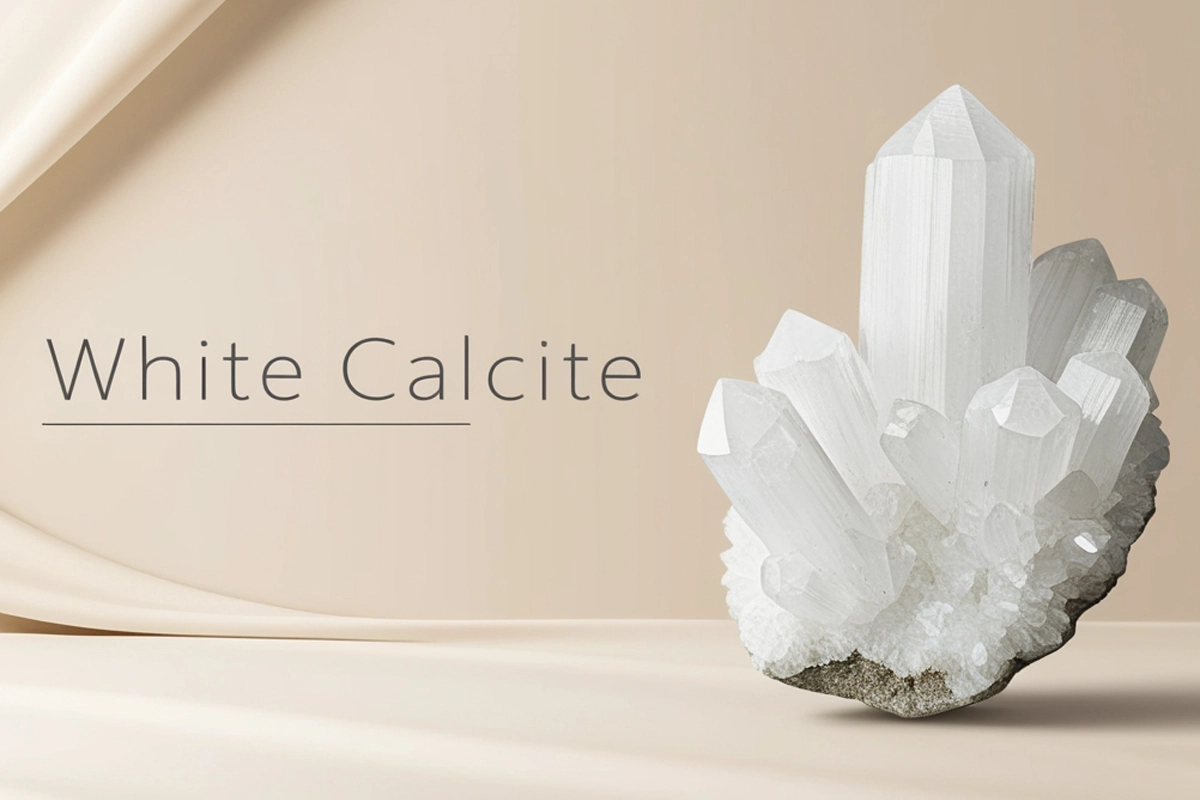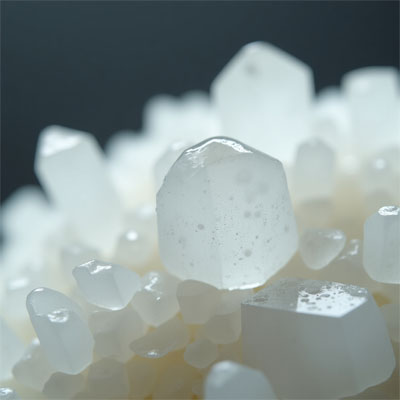
What is White Calcite
I remember the first time I held a piece of white calcite its cool surface, soft translucent color, and gentle glow instantly pulled me in. As someone who’s worked closely with natural stones and minerals for years, I can tell you that this isn’t just any gemstone; it’s a truly versatile and powerful mineral. What makes it even more fascinating is its hexagonal prism shape, often forming beautiful crystals that reflect light with a double refraction, making it appear even brighter than other stones of its kind.
Scientifically, white calcite is composed of calcium carbonate or CaCO3. It forms when this compound is dissolved in water and later deposited by natural organisms like corals, shells, and algae. You’ll often find it in sedimentary rocks such as limestone and marble, or in hydrothermal veins, cavities, and even within igneous formations. Its abundant and diverse presence in different geological environments proves just how essential this mineral has been through human history and culture.
As an artist and a collector, I’ve seen white calcite used in everything from construction materials to artistic and decorative displays. But beyond the physical, its metaphysical properties are what draw many to it. It radiates a soothing energy that helps reduce stress, and many believe it can promote mental clarity, emotional strength, and inner balance. Some pieces form as cubes, needles, spheres, or clusters, each adding to its variety and visual charm. With its soft colors and strong energy, white calcite remains one of my go-to stones for both display and spiritual support.
The history of white calcite reaches back to ancient times, where this remarkable crystal was formed within limestone deposits across the world. As part of the group of minerals known as the class of carbonates, it results when calcium ions interact with carbonate molecules, creating different types of formations. I remember seeing a sample in a geological museum’s collections, where it was explained that these formations began billions of years ago in shallow seas through the activity of cyanobacteria. Over millions of years, growth occurred gradually, layering on top of existing crystals in a slow process that created intricate structures. These specimens, often admired for their geometric shapes, sparkling facets, and delicate beauty, became popular in both healing and artistic circles. The lore tied to calcite is truly fascinating, filled with stories that have captivated humans for centuries due to its healing, metaphysical, and construction properties, and its use in ancient materials reflects a diverse and rich history.
History Of White Calcite

White Calcite in Ancient Civilizations
I’ve always been amazed by how ancient civilizations harnessed calcite. From building majestic temples, tombs, and monuments, to constructing the pyramids of Egypt with blocks of limestone made primarily of calcite, its architectural significance stands unmatched. The Romans took it a step further by using marble, a metamorphosed, calcite-rich stone, to build the Pantheon, Colosseum, and other iconic masterpieces. As an artist, I admire how this mineral’s softness and workability made it a perfect medium for sculpture and art, enabling the carving of fine details and lifelike expressions in stone.
Optical Calcite and the Vikings
One of the most compelling uses of optical calcite comes from the Vikings. During the Viking Age, Norse people are believed to have used Icelandic spar a transparent form of calcite as a navigational tool. These “sunstones” helped them locate the sun’s position even on overcast days or below the horizon, using the polarization patterns in the sky. This ingenious technique allowed safe passage across the oceans with impressive precision, long before the magnetic compass existed.
Metaphysical Properties and Crystal Healing
In the world of healing, white calcite, especially the clear variety, is often associated with powerful energies. It’s said to cleanse and amplify energy, making it ideal for meditation, spiritual work, and achieving mental clarity. I’ve personally used it to focus during difficult decisions it subtly boosts decision-making abilities. Some prefer Mexican onyx, another calcite-based stone, for its positive, inner strength, a symbol of personal growth and well-being.
White Calcite in Modern Times
Today, white calcite remains a modern, essential part of many industries and applications. In design, flooring, countertops, and decorative accents are often made with calcite-based marble. It’s also vital to cement production. In tech, its optical features have advanced technology used in polarizing filters, precision instruments, and even 3D movie glasses. This unique combination of utility, beauty, and geological intrigue ensures calcite’s continued appeal and relevance in our everyday lives.
- I’ve worked with many minerals over the years, but white calcite remains one of the most fascinating to observe up close.
- This mineral, often formed through the process of sedimentation, is made of calcium carbonate and has a colorless or milky appearance that reveals a distinct crystalline structure.
- It’s characterized by perfect cleavage, meaning it has a tendency to break cleanly along a specific plane.
- With a low hardness rating of 3 on the Mohs scale, it’s relatively soft, easily scratched, and often brittle.
- When exposed to acid, it produces carbon dioxide gas, making it incredibly useful in testing the acidity of other substances.
- You’ll find it in sedimentary, metamorphic, and igneous rocks, and I’ve personally used it in both construction and agriculture due to its neutralizing properties.
Physical Properties Of White Calcite

In my experience with natural minerals, I’ve often seen that white calcite isn’t exactly rare, but it can be surprisingly hard to find depending on the prevalence of deposits in different parts of the world. It typically occurs in sedimentary rocks like limestone, and its color can vary from clear or snowy white to yellowish or even brown tones. Thanks to its softness, it’s incredibly easy to work with, which lowers labor costs and makes it more widely accessible for both ornamental and industrial uses. Whether carved into stone jewelry or used in carvings, or processed for applications like fertilizer, cement production, or even in pharmaceuticals, this mineral proves itself versatile. The multiple applications of calcite make it one of the more useful and underestimated minerals in my collection.
Is White Calcite Rare?

Benefits and Healing Properties of White Calcite

I’ve always been drawn to crystals, but discovering white calcite was different it felt like finding a key to something deeper. This renowned, versatile stone has a diverse range of healing properties that deeply resonate with me. What makes it special is its ability to harness subtle energy that can truly transform our lives. I noticed how simply tapping into it during quiet moments helps promote emotional, physical, and spiritual well-being. It’s not just a rock, it’s a powerful tool that offers benefits for the whole self, and I’ve seen how it can work wonders when used intentionally.
Physical Strength and Detox Support
When I began using white calcite during recovery from burnout, the physical changes were subtle but steady. It seemed to support the revitalization of my body by helping me feel lighter, like a natural detoxify process was at play. It’s said to aid in the elimination of toxins and support the proper functioning of organs. What fascinated me most was how this calcium carbonate mineral is believed to resonate with the skeletal system, which aligns with my improved posture and less joint stiffness. It’s like the energy of white calcite helped maintain strong bones, ease inflammation, and promote vitality. The flow of life force, or chi, felt harmonious almost like it was helping to release stagnant energy and remove deep blockages that were slowing down my healing processes.
Emotional Calm and Personal Reflection
Using white calcite as part of my meditation practice created a surprising emotional shift. Its soothing, nurturing energy felt like a warm balm on the heart. I started to recognize and honor my emotions instead of pushing them aside. It helped me heal old wounds of anger, fear, and resentment, allowing me to cultivate a healthier emotional landscape. Simply holding a piece during reflection helped foster inner peace and tranquility. Life’s ups and downs became easier to navigate with grace and ease. Over time, I gained more self-awareness, could reflect on my experiences, and even began to develop better boundaries in my relationships. It’s truly empowering how a simple crystal can help nurture and protect your emotional well-being.
Emotional Calm and Personal Reflection
Using white calcite as part of my meditation practice created a surprising emotional shift. Its soothing, nurturing energy felt like a warm balm on the heart. I started to recognize and honor my emotions instead of pushing them aside. It helped me heal old wounds of anger, fear, and resentment, allowing me to cultivate a healthier emotional landscape. Simply holding a piece during reflection helped foster inner peace and tranquility. Life’s ups and downs became easier to navigate with grace and ease. Over time, I gained more self-awareness, could reflect on my experiences, and even began to develop better boundaries in my relationships. It’s truly empowering how a simple crystal can help nurture and protect your emotional well-being.
How to Use White Calcite
Meditation with White Calcite
When I meditate with white calcite, I begin by finding a quiet, comfortable space where I can sit or lie down. I hold the stone in my hand, place it on my crown chakra, and breathe deeply, letting my body and mind relax. I focus my attention on its gentle, nurturing energy, letting it cleanse my field, clearing away anything negative or stagnant. I often repeat a personal affirmation, such as “I am connected to divine wisdom,” to help align my inner spirit with this powerful ally. It feels like the light and clarity of the stone is filling my entire being, helping me cultivate awareness, peace, and a deeper connection to myself and the universal love within.
Using White Calcite in Feng Shui
In my feng shui practice, white calcite has become an excellent way to enhance the flow of energy in both home and workspace. I often place it near the entrance to purify the energy that’s entering, and in the living room to help promote harmony among family members and guests. Its cleansing properties work best when strategically used in spaces that need mental clarity, such as an office or desk. I love how this ancient Chinese practice, combined with crystals, can create an energetic and positive environment, helping me work more effectively and efficiently.
Using White Calcite at Home and Work
At home and work, I rely on white calcite to keep the environment balanced and peaceful. I’ve placed it on my desk to maintain mental focus and in my bedroom to encourage restful sleep. I also like keeping it in communal spaces, like the dining room, to support open communication and an emotional atmosphere that feels welcoming for both members of the family and visitors. Its energy is subtle but powerful, helping me feel grounded throughout my daily lives.
White Calcite for Love and Relationships
For love and relationships, white calcite is a deeply nurturing tool I often use to foster connection and compassion. I’ve created a small altar in my bedroom where I’ve placed a piece of the stone alongside symbols of unity and partnership. Sometimes, I’ll meditate with it while setting intentions for understanding, supporting each other, and strengthening our bond. I’ve even gifted it to my partner as a tangible reminder of our commitment and shared care. This ritual helps maintain the balance in our relationship, making it feel more heartfelt and meaningful.
FAQ'S:
Calcite stone is for what chakra?
White Calcite is most often associated with the Crown Chakra, located at the top of the head, and is believed to support spiritual connection and mental clarity.
What is the rarest color of calcite?
Among the many shades calcite comes in, purple, violet, and lavender are considered the rarest. Their unique tones are generally due to trace elements like manganese altering the crystal’s natural formation.
Is calcite metallic or non-metallic?
Calcite is a non-metallic mineral. Its appearance ranges from a vitreous (glass-like) to a pearly shine, which clearly places it in the non-metallic category.
Is Calcite good for your skin?
While calcite isn’t scientifically proven to directly benefit the skin, some practitioners in crystal healing believe that its energetic properties, especially White Calcite, may support overall wellness that can reflect in a healthier complexion.
Can I put Calcite in the sun to charge?
Yes, calcite can be charged in sunlight, but only for a short period. Overexposure can cause it to fade or become brittle, so it’s best to leave it in the sun for just a few hours at a time.
